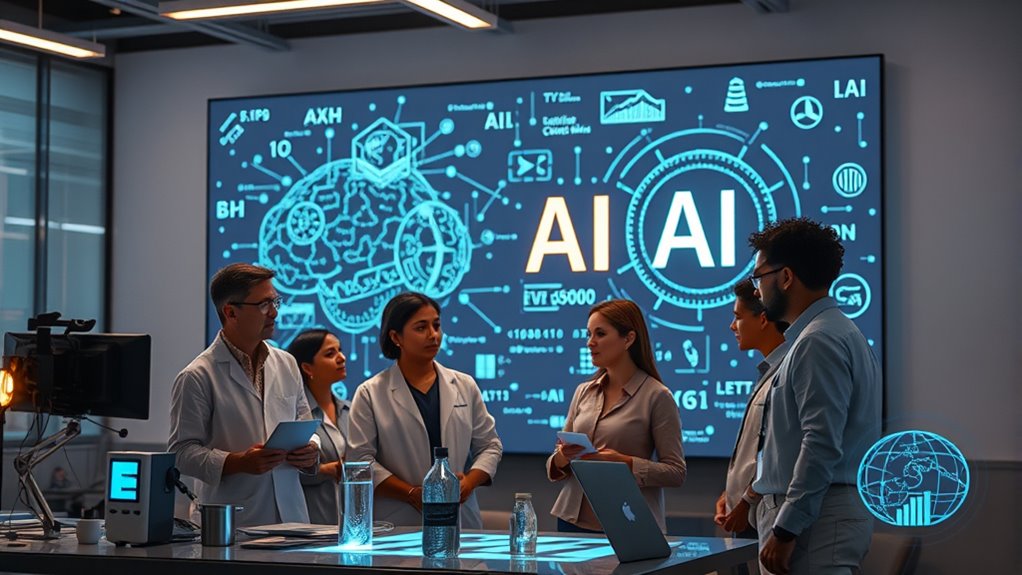In AI-driven development, you must prioritize ethical considerations like fairness, transparency, and accountability. Avoid bias by selecting diverse data and testing for discriminatory outcomes. Implement security measures to prevent manipulation and conduct regular audits to uncover emerging issues. Be transparent about your processes and decision criteria to build trust. By embracing responsible innovation and aligning with societal values, you’ll create AI that benefits everyone. Continue exploring to learn how to integrate these principles effectively.
Key Takeaways
- Prioritize bias mitigation through diverse data, testing, and bias-reduction algorithms to ensure fairness in AI systems.
- Maintain transparency by documenting data sources, decision criteria, and processes to build stakeholder trust.
- Implement robust AI security measures to detect and prevent biased algorithm manipulation and adversarial attacks.
- Conduct regular audits and ongoing evaluations to identify and address emerging biases or ethical issues.
- Foster a culture of responsible innovation by aligning AI development with societal values, human rights, and ethical standards.

As artificial intelligence becomes increasingly integrated into development processes, addressing ethical considerations is more essential than ever. You need to ensure that AI systems are fair, responsible, and trustworthy, which begins with understanding the importance of bias mitigation. Bias in AI can lead to unfair treatment of certain groups, reinforce stereotypes, or produce skewed results that harm users and society. To prevent this, you must actively identify and reduce biases during the development cycle. This involves carefully selecting diverse training data, regularly testing models for discriminatory outcomes, and implementing algorithms designed to mitigate bias. It’s not enough to develop an AI that works; you have to develop an AI that works fairly. Achieving this requires a proactive approach to bias mitigation, recognizing potential sources of bias at each stage and addressing them before they cause harm. Incorporating diverse design approaches can help ensure that AI systems are more inclusive and equitable. Additionally, fostering inclusive development practices can further reduce the risk of unintended bias influencing outcomes. Moreover, leveraging AI security measures can help detect and prevent biased algorithm manipulation or adversarial attacks that could skew results. Establishing comprehensive testing protocols is also vital to continuously monitor and address biases throughout the AI lifecycle. Alongside bias mitigation, establishing transparency standards is fundamental in building ethical AI. Transparency means making your processes, data sources, and decision-making criteria clear to stakeholders. When users and regulators understand how your AI system operates, they can better assess its reliability and fairness. You should document your data collection methods, model choices, and testing procedures thoroughly. This openness fosters trust and accountability, helping to prevent black-box scenarios where decisions are opaque or unexplainable. Transparency standards also encourage continuous improvement, as feedback from users and external audits can identify areas for refinement. By openly sharing information about your AI’s functioning and limitations, you demonstrate your commitment to ethical development and build confidence among users. Implementing bias mitigation and transparency standards isn’t just about compliance; it’s about responsible innovation. You must recognize that AI’s impact extends beyond technical performance, influencing social norms and individual lives. Ethical development requires ongoing vigilance, regular audits, and a willingness to adapt based on new insights. You should foster a culture that prioritizes ethical considerations, encouraging your team to question assumptions and prioritize fairness. Remember, the goal isn’t just to create effective AI systems but to develop technology that aligns with societal values and respects human rights. By embedding bias mitigation strategies and transparency standards into your workflow, you take essential steps toward responsible AI development that benefits everyone, not just a select few.
Frequently Asked Questions
How Can AI Bias Be Effectively Detected and Mitigated?
To detect and mitigate AI bias, you should regularly evaluate your algorithms for signs of bias, focusing on algorithmic fairness. Use diverse datasets and perform bias testing to uncover hidden biases. Implement bias mitigation techniques like reweighting or debiasing algorithms. By continuously monitoring and adjusting your models, you guarantee fairer outcomes, helping your AI systems make equitable decisions and reducing unintended harm caused by bias.
What Are the Best Practices for Ensuring AI Transparency?
You should prioritize AI transparency by clearly documenting your algorithms, making them understandable to users and stakeholders. Guarantee algorithm accountability by regularly reviewing and updating models to prevent bias and errors. Protect user privacy by implementing robust data handling practices and explaining how data is used. Open communication about AI decision-making builds trust, helping users feel confident that your system operates ethically and responsibly.
How Should Developers Address Unintended AI Consequences?
Imagine you’re living in a sci-fi universe, yet AI moral dilemmas are real. You should proactively identify potential unintended consequences by rigorously testing your models and monitoring their real-world impact. When issues arise, be transparent and take swift action. Emphasize developer accountability by updating algorithms responsibly and involving diverse perspectives. Addressing unintended AI consequences guarantees your creations remain ethical, trustworthy, and aligned with societal values.
What Legal Frameworks Govern AI Ethical Standards Globally?
You should understand that global legal frameworks like international treaties and regulations shape AI ethical standards. These frameworks guide how developers ensure conformity across borders, promoting responsible AI use. By adhering to regulatory compliance requirements, you help prevent misuse and address potential harms. Staying informed about international treaties and evolving laws helps you develop ethically sound AI systems that respect diverse legal standards worldwide.
How Can Stakeholders Be Involved in AI Ethical Decision-Making?
You can involve stakeholders in AI ethical decision-making by promoting active stakeholder engagement through regular consultations and collaborative platforms. Encourage diverse voices, including users, developers, and policymakers, to contribute their perspectives. Establish clear channels for feedback and ensure ethical oversight committees include varied stakeholder representatives. This approach helps create balanced, transparent decisions, fostering trust and accountability in AI development processes.
Conclusion
As you navigate AI-driven development, remember that ethics are the compass guiding your journey. By considering fairness, transparency, and accountability, you steer clear of pitfalls like a lighthouse guiding ships safely to shore. Embracing ethical practices isn’t just a duty; it’s the beacon that guarantees your innovations serve humanity’s best interests. Keep these principles close, and you’ll create AI that not only advances technology but also upholds our shared values.









